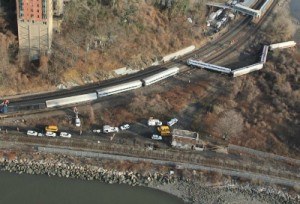

A Metro-North Railroad train derailed in New York’s Bronx borough early today, killing four and injuring 63, adding to the rail line’s year of accidents.
Yesterday’s accident in the Riverdale section of the Bronx left red and silver railcars on their sides with the lead car on the bank of the Harlem River. It marked the third time in a year that Metro-North service to New York has been forced to shut down because of an accident.
In September and October, service on the railroad’s New Haven line was disrupted for almost two weeks when a Consolidated Edison Inc. power failure interrupted service for 130,000 passengers daily in Connecticut and suburban Westchester County in New York. That followed a May 17 collision in Connecticut between two trains going opposite directions. The accident involved 700 passengers, all of whom survived.

In yesterday’s accident, all seven passenger cars being pushed by a diesel locomotive derailed. Three of the four people who died were thrown from the train, FDNY Chief of the Department Edward Kilduff said at a press conference. Eleven of the injured are critically hurt, said New York City fire Commissioner Salvatore Cassano.
Injured passengers were taken to Jacobi Medical Center, Montefiore Medical Center, New York Presbyterian Hospital and St. Barnabas Hospital, according to WABC-TV in New York. Of the 10 people being treated at St. Barnabus, injuries include knee fractures and a spine fracture.
The U.S. National Transportation Safety Board sent a team to the scene.
The fire department said the accident was reported via a 911 emergency call at 7:20 a.m. from the scene, said New York City fire department spokesman Michael Parrella.
The crash happened in a curving section of track near where the Hudson and Harlem rivers meet, Aaron Donovan, a MTA spokesman, said in a telephone interview. None of the derailed cars were submerged in water.
The derailment adds to Metro-North accidents this year, two of which the safety board is already investigating.
The collision near Bridgeport, Connecticut on May 17 injured dozens of passengers and led the NTSB to prod the railroad to change its track inspection procedures. The board also probed a rail worker death on the railroad 11 days later.
“We’ll be looking for any similarities between this one and the one in Bridgeport,” said Kelly Nantel, a NTSB board spokeswoman. NTSB member Earl Weener will lead the probe of yesterday’s crash.
In that crash, new railcars made by Kawasaki Heavy Industries Ltd. that were required to meet tightened U.S. safety standards were credited for saving lives.
The cars in yesterday’s crash were a different model made by Bombardier Inc., made for use with a diesel rather than electric locomotive, Donovan said. Bombardier, which supplied Amtrak’s Acela fleet that serves the U.S. Northeast between Washington and Boston, is based in Montreal.
Senator Richard Blumenthal, a Connecticut Democrat, has said the earlier accidents show rail safety needs more money and attention.
U.S. rail-safety regulators on Nov. 29 finalized a rule intended to make it easier for passengers on Amtrak and U.S. commuter railroads such as Metro-North to escape trains after accidents. The Federal Railroad Administration finalized the rule, which will apply only to new railcars, 16 years after the NTSB recommended it.
The safety board called for egress improvements after a 1996 crash in Silver Spring, Maryland, that killed eight passengers and three crew members when Amtrak and Maryland Area Regional Commuter trains collided. Passengers were trapped after door emergency-release handles were damaged by fire and the interior lighting system didn’t work after the crash.
Yesterday’s derailment happened near the Spuyten Duyvil station, which the southbound express train didn’t stop at. Train No. 8808 left Poughkeepsie, New York, at 5:54 a.m. and was due to arrive at Grand Central Terminal at 7:43 a.m., Donovan said.
Julia Worcester, an 18-year-old freshman at Mount Holyoke College home, said she was awakened at her home overlooking the Hudson by the crash.
“I was asleep and it woke me up,” she said in an interview. “It was just a huge boom. It shook the top floor of our house.”
Service on Metro-North’s Hudson Line is suspended in both directions between Croton-Harmon station and Grand Central Terminal, he said. Amtrak Empire Service between New York City and Albany, New York, was also halted, and it’s unknown when service will be restored.
The Associated Press reported today that President Obama was briefed on the accident.
Family members in New York can call 311 for more information. Outside of New York, they can call 212-NEW-YORK (212-639-9675). John F. Kennedy High School in the Bronx has been established as the family center and can be reached at 718- 817-7444.
(With assistance from Dan Hart in Washington and William Glasgall, Nancy Moran and Henry Goldman in New York. Editors: Sylvia Wier, Crayton Harrison.)